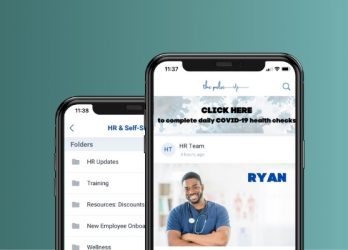Last updated on March 7, 2024 at 10:33 am
Effective collaboration is the backbone of any successful organization. It enables teams to share knowledge, skills, and resources to achieve common goals. However, in today’s fast-paced business world, where remote work and global teams are becoming increasingly prevalent, traditional methods of communication and collaboration may no longer be enough. This is where an employee intranet comes into play as a powerful tool for fostering team collaboration. In this blog post, we will delve deep into the role of employee intranets in enhancing teamwork and how it can benefit organizations of all sizes and industries. So if you’re looking for ways to improve your team’s collaboration and productivity, keep reading!
The Collaboration Challenge in Modern Workplaces
In recent years, there has been a significant shift in the way employees connect and collaborate. According to a Gartner report, the percentage of in-person meetings has decreased from 63% to 33% within a span of two years. This trend is expected to continue, with projections indicating that only 25% of official meetings will be held in person by 2024.
As organizations adapt to these changes, it is crucial to address the challenges of this modern work environment and find effective methods to foster collaboration and engagement among team members. Here are some key challenges to consider:
Physical and geographic distance
Decreased personal interactions in a hybrid workspace can give rise to workplace issues. Inefficient communication can trigger a chain reaction of problems, hindering workflow efficiency, causing misunderstandings, and reducing camaraderie among coworkers. A recent report by Grammarly and the Harris Poll emphasizes the significant financial impact of poor communication. The report reveals that U.S. companies lose approximately $1.2 trillion annually as a consequence of ineffective communication.
Communication gaps and inefficiencies
Effective communication is vital for fostering trust and alignment among team members. However, limited or improper communication can lead to misunderstandings and discord. Digital communication channels, such as emails, lack the cues of body language, facial expressions, and tone of voice, making it challenging to accurately interpret the meaning and intention behind messages.
Lack of transparency
Lack of transparency undermines trust among individuals and hampers collaboration. Concealing or misrepresenting information within a team can lead to hesitancy in trusting and working together with fellow members.
Information silos
Information silos have long been a challenge for organizations. Departmental reluctance to share work details can hinder collaboration. When team members lack access to shared documents, files, and information, effective coordination becomes difficult. To maintain team unity, it is crucial to keep remote workers connected and engaged.
Lack of trust and engagement
A lack of trust in the workplace fosters a hostile environment that can cripple collaboration, hinder communication, and ultimately sabotage project success. Your staff may feel alone or unsupported, which will result in poor teamwork, diminished work involvement, missed deadlines, decreased innovation, and a general atmosphere of apathy.
The Employee Intranet: A Collaboration Powerhouse
From an intuitive user experience to real-time communication, an employee intranet provides a great solution for leaders trying to navigate the challenges of hybrid and remote work settings.
Centralized Workspace
The employee intranet serves as a centralized hub for the company’s vital information, fostering communication, team collaboration, and knowledge-sharing. This platform offers a range of information, including the employee directory, essential customer management policies, the code of ethics, software information, and more. Moreover, by providing availability and easy accessibility to information in a single location, it helps prevent duplication of effort.
Real-Time Communication
Real-time communication through an employee intranet provides a seamless platform for instantaneous information exchange within an organization. This digital infrastructure enables employees to connect, share ideas, and collaborate in real-time, fostering a dynamic and agile work environment. The intranet serves as a centralized hub where teams can engage in instant messaging, video conferencing, and document sharing, breaking down geographical barriers and facilitating efficient communication. With the ability to access critical updates, project developments, and announcements in real-time, employees can stay well-informed, enhancing overall productivity and teamwork.
Collaborative Tools and Features
Collaborative tools and features integrated into an employee intranet have revolutionized the way organizations facilitate communication and cooperation among their workforce. These sophisticated tools, ranging from shared document repositories to real-time messaging platforms, empower employees to collaborate seamlessly, regardless of geographical distances. The employee intranet serves as a centralized hub, fostering a collaborative culture by enabling team members to collaborate on projects, share insights, and contribute to discussions effortlessly. Features like document version control ensure that teams work on the latest information, while collaborative editing capabilities streamline the content creation process.
Knowledge Sharing and Search
Employee intranets serve as invaluable platforms for fostering a culture of collaboration and information exchange within an organization. Through these internal networks, employees can effortlessly share their expertise, insights, and best practices, contributing to a collective pool of knowledge. This not only enhances team collaboration but also accelerates problem-solving and innovation. Additionally, the search functionality embedded in these intranets streamlines the process of accessing relevant information. Employees can quickly retrieve documents, policies, and insights, saving time and promoting productivity.
Social Features and Community Building
Implementing social features in an employee intranet system can significantly enhance communication, collaboration, and community building within an organization. By integrating features such as discussion forums, chat rooms, and employee profiles, the intranet becomes a dynamic platform that fosters connections among team members.
This not only facilitates information sharing but also creates a sense of belonging and camaraderie among employees, even in geographically dispersed teams. Additionally, community-building initiatives, such as employee recognition programs and virtual events, can be seamlessly incorporated into the intranet, promoting a positive corporate culture.
Also Read: Employee Engagement Apps vs. Intranets
Practical Ways the Intranet Improves Team Collaboration
The following are the practical benefits of the intranet in business:
- Project Management and Tracking: Utilizing the intranet for real-time business operations enhances the ability to advance new projects and address challenges promptly. This central platform streamlines collaboration, communication, and knowledge exchange, resulting in improved productivity and team dynamics.
- Brainstorming and Idea Sharing: By creating targeted online communities, businesses can invite specific individuals to share and discuss ideas. The intranet facilitates meaningful conversations, fostering fruitful exchanges rather than a collection of random ideas.
- Document Co-Creation and Editing: Collaborative document editing features allow multiple individuals to access, edit, and share documents simultaneously. This encourages cooperation, leveraging diverse skills, and enabling distributed decision-making.
- Virtual Team Building and Social Events: Employee intranets with team-building and social features foster a positive work culture, with mobile accessibility ensuring participation on the go. Moreover, gamification enhances the learning experience.
- Cross-Departmental Collaboration: The intranet facilitates real-time feedback collection, easy access to training resources, and data-driven decision-making through analytics. Workflow software enables seamless collaboration, connecting teams regardless of their location.
- Cross-Departmental Collaboration: The intranet facilitates real-time feedback collection, easy access to training resources, and data-driven decision-making through analytics. Workflow software enables seamless collaboration, connecting teams regardless of their location.
- Integration of Task Management Tools: The intranet can seamlessly integrate with task management tools, enabling teams to efficiently organize, assign, and track tasks within the same platform. This integration streamlines workflow, reduces redundancies, and enhances overall task visibility and accountability.
- Employee Recognition and Appreciation: Implementing features for employee recognition and appreciation within the intranet promotes a positive and collaborative work culture. Teams can acknowledge and celebrate achievements, fostering a sense of accomplishment and motivation among team members.
- Knowledge Base and FAQs: Establishing a comprehensive knowledge base and Frequently Asked Questions (FAQs) section on the intranet ensures that team members have easy access to essential information. This promotes self-service, reduces dependency on support functions, and enhances efficiency by addressing common queries swiftly.
Summing Up
In conclusion, the employee intranet stands as a linchpin in revolutionizing team collaboration within organizations. By seamlessly integrating real-time communication, project management tools, and collaborative features, it transcends conventional workplace boundaries. The intranet fosters an environment where ideas flow freely, projects move swiftly, and knowledge is shared effortlessly. It not only connects teams across departments and geographical locations but also serves as a dynamic hub for virtual team building and social events, nurturing a positive work culture.
Frequently Asked Questions
Q1 . What is an employee intranet, and how does it facilitate team collaboration?
An employee intranet is a private network within an organization that serves as a centralized platform for communication and collaboration. It includes tools such as document sharing, messaging, and project management. Its role in team collaboration lies in providing a unified digital space where team members can communicate, share resources, and work together seamlessly.
Q2. How does an employee intranet enhance communication among team members?
Employee intranets offer various communication channels, such as instant messaging, discussion forums, and announcement boards. These tools foster real-time communication, allowing team members to share ideas, updates, and information swiftly. This enhances overall communication efficiency and ensures that everyone is on the same page, promoting a collaborative work environment.
Q3. How does an intranet support remote and dispersed teams in their collaboration efforts?
Employee intranets play a crucial role in supporting remote and dispersed teams by providing a virtual workspace accessible from anywhere with an internet connection. Through video conferencing, document sharing, and collaborative tools, remote team members can engage in real-time communication and work together seamlessly. This fosters a sense of connection and ensures that geographical barriers do not hinder effective collaboration.
Subscribe To The theEMPLOYEEapp Newsletter
hbspt.forms.create({
region: “na1”,
portalId: “41809”,
formId: “5be85d94-6aae-48d1-9f07-ac870bc56193”
});
Comments are closed.




